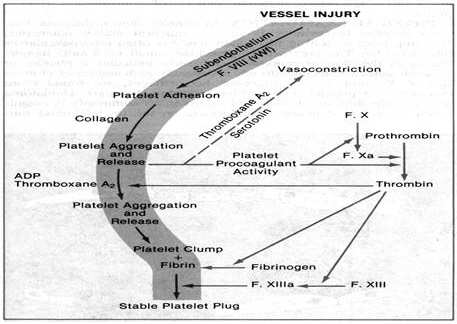Difference between revisions of "혈전증 (thrombosis)"
| Line 18: | Line 18: | ||
<br /> | <br /> | ||
<strong>3. Consoldation</strong><br /> | <strong>3. Consoldation</strong><br /> | ||
| − | - 호중구, 적혈구가 접촉 후 혈전을 형성하는 동시에 퇴축한다. 섬유소 용해작용 (fibrinolysis)은 내피세포에서 방출된 tPA (tissue plasminogen activator)에 의해 개시되고, 혈전증은 역시 내피세포에서 방출된 1) thrombomodulin (thrombin과 결합하여 protein C를 활성화시키고, protein C는 역으로 응고 인자인 Va와 V3a를 분해) 2) heparin like molecule (antithrombin 3와 complex를 형성하여, thrombin을 불활성화시키고, 응고 인자인 Xa와 X1a를 분해) 이 두 가지를 포함한다.</font></p> | + | - 호중구, 적혈구가 접촉 후 혈전을 형성하는 동시에 퇴축한다. 섬유소 용해작용 (fibrinolysis)은 내피세포에서 방출된 tPA (tissue plasminogen activator)에 의해 개시되고, 혈전증은 역시 내피세포에서 방출된 1) <strong>thrombomodulin</strong> (thrombin과 결합하여 protein C를 활성화시키고, protein C는 역으로 응고 인자인 Va와 V3a를 분해) 2) <strong>heparin like molecule</strong> (antithrombin 3와 complex를 형성하여, thrombin을 불활성화시키고, 응고 인자인 Xa와 X1a를 분해) 이 두 가지를 포함한다.</font></p> |
Revision as of 15:01, 19 October 2006
혈전 (thrombus) : 혈관 내에서 응고된 혈액 성분의 고형 덩어리로서, 혈소판, 섬유, 세포들로 구성되어 있으며 균일하지 않은 구조를 가진다.
혈전증 (thrombosis) : 혈관 내에서 혈전이 형성되는 것.
혈전증이 일어나는 단계

1. Adhesion & Secretion
- 내피 세포가 손상되면, vWF가 방출되고, 혈소판에 콜라겐이 노출된다.
- 혈소판이 기저막의 단편과 콜라겐에 부착한다.
** ADP, 5-HT (serotonin), thromboxane (TXA2)의 혈중으로의 방출은 콜라겐을 유인하고 활성화시칸다.
** prostaglaidin, nitric oxide는 혈전이 확장되는 것을 방지한다.
2. Recruitment & aggregation
- 혈소판의 활성은 혈소판의 방출을 초래한다.
- 혈소판의 방출로 인해 응고, 응집이 자극되는데 혈소판 위에 존재하는 phospholipoprotein은 thrombin을 끌어당겨 fibrin (섬유소) 형성을 시작한다.
3. Consoldation
- 호중구, 적혈구가 접촉 후 혈전을 형성하는 동시에 퇴축한다. 섬유소 용해작용 (fibrinolysis)은 내피세포에서 방출된 tPA (tissue plasminogen activator)에 의해 개시되고, 혈전증은 역시 내피세포에서 방출된 1) thrombomodulin (thrombin과 결합하여 protein C를 활성화시키고, protein C는 역으로 응고 인자인 Va와 V3a를 분해) 2) heparin like molecule (antithrombin 3와 complex를 형성하여, thrombin을 불활성화시키고, 응고 인자인 Xa와 X1a를 분해) 이 두 가지를 포함한다.